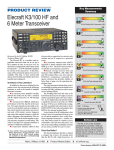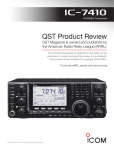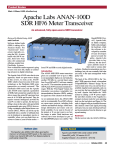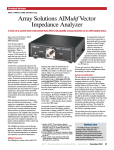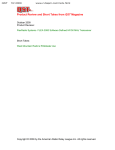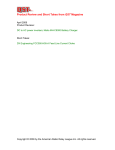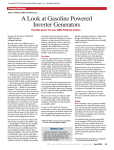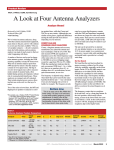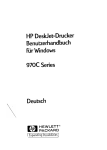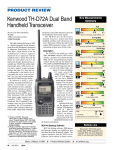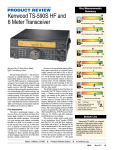Download Sat-Light 7410F Instruction manual
Transcript
i9100 HF/VHF/UHF Transceiver QST Product Review QST Magazine is owned and published by the American Radio Relay League (ARRL). Icom America expresses its gratitude to the ARRL for the permission to reprint and post this review on our Website. This product review remains the copyright of the ARRL. To join the ARRL, please visit www.arrl.org ©2012 Icom America Inc. The Icom logo is a registered trademark of Icom Inc. TechnicalReview Product by Mark Spencer, WA8SME Mark J. Wilson, K1RO, [email protected] ICOM IC-9100 MF/HF/VHF/UHF Transceiver ICOM’s new dc to daylight transceiver raises the bar. Reviewed by Rick Lindquist, WW3DE National Contest Journal Managing Editor [email protected] The only real problem I encountered with the ICOM IC-9100 was getting it away from the delivery guy, a budding ham. He was taken by what was on the outside of the ICOM packing box. Users, however, have been impressed by what’s inside the box of this solid-performing dc-to-daylight, all-in-one transceiver. The IC-9100 is essentially the “plus” version of the IC-7410 reviewed in October 2011, and it shares many traits with that radio vis-à-vis its HF and 50 MHz capabilities, which we won’t reiterate here in detail.1 But it’s not quite that straightforward. With the IC-9100’s substantially higher price tag come the IC-7410’s HF and 6 meter performance plus all-mode VHF, UHF and satellite features and capabilities. Think of it as a shack in a box. Is the IC-9100 a good value and match for your operating style and preferences — not to mention your budget? We’ll report. You decide. Let’s take a look. Genealogy We’re tempted to think of the IC-7410 and IC-9100 solely as descendants of ICOM’s venerable IC-746/756 platform (with a bit of IC-706 DNA thrown in for good measure). But, the ’9100’s nomenclature also recalls ICOM’s noteworthy VHF-UHF three-band all-mode transceiver of a decade ago, the IC-910H. It comes as no surprise that the IC-9100 has retained the best features of its older sibling. ICOM and other manufacturers offer several all-mode transceivers that cover from HF through 440 MHz. The IC-9100, however, is only one of two currently available desktop radios that include an option for 1.2 GHz. Fish or Fowl? ICOM has done a creditable job of balancing the IC-9100’s HF+50 MHz performance with 1R. Lindquist, N1RL, “ICOM IC-7410 HF and 6 Meter Transceiver,” Product Review, QST, Oct 2011, pp 49-54. This review and reviews of the other ICOM transceivers mentioned here are available to ARRL members online at www.arrl.org/product-review. its expanded VHF and UHF coverage and capabilities. The bare-bones IC-9100 is a full-featured 100 W transceiver for HF, 6 meters, 2 meters and provides 75 W on 70 cm, with all the goodies you’d expect for FM simplex and repeater operation plus satellite work. With our IC-9100 we ordered the optional UX-9100 23 cm module (10 W), UT-121 D-DSTAR module, optional narrow 1st IF (“roofing”) filters for HF and 50 MHz and the RS-BA1 IP Remote Control Software package that permits remote control via the Internet or other IP network (more on this later). Add a power supply and antennas, and you’re ready to cover considerable Amateur Radio real estate in relative style — without even having to be in your shack! Doubling and Tripling Down Packing these expanded capabilities into a box that’s very similar to the IC-7410’s and that has a nearly identical front panel requires many dual-purpose (or multi-purpose) buttons and controls. The labels are the same, nicely contrasting white-on-black style as the ’7410’s and easy to read, once you’ve deciphered the abbreviations dictated by space restrictions. Legends for some second and third-tier functions can be harder to make out. Good shack lighting helps considerably. The ’9100’s broader and more-complex range of functions, especially those reserved for satellite work, means a steeper learning curve. The IC-9100 diverges from the IC-7410 in several significant ways, starting with the front panel, where there’s been a bit of musical chairs between models. The ’9100 features two independent receivers and can receive on two bands at the same time — although not on two HF bands. There’s a single MAIN DIAL for tuning, but the main and sub receivers do have separate (and concentric) AF GAIN and SQUELCH controls. With a stereo headset (or separate speakers) you can listen to both receivers at the same time, one in each ear. To do things such as operating split on HF means setting up VFO A and VFO B to the appropriate frequencies (you can designate a default split — say, 2 kHz — via the menu). The split function is independent from the repeater split function, also set via the menu. The ’9100 includes a DV/DR button (for digital voice/digital repeater operation) among the Bottom Line Compact and versatile, the IC-9100 handles almost any type of operating on the 160 meter through 2 meter bands, plus 70 and 23 cm. QST – Devoted Entirely to Amateur Radio www.arrl.org April 2012 51 mode buttons, which are bracketed by the MENU and FILTER buttons. Given the addition of the DV/DR button, the ’9100 does not have separate CW and RTTY mode buttons as on the ’7410. There is a single CW/RTTY key. There are other accommodations. Take notes! There will be a quiz. Since the main receiver’s AF/RF SQUELCH controls take up the spot where the MIC and RF PWR controls live on the ’7410, ICOM has relegated these functions to the row of four stem controls along the lower apron of the front panel. The ’9100’s stem controls are sturdier than the ones on, say, the IC-756PROIII, but it’s difficult to determine their relative settings. The other two stem controls are for CW PITCH and KEY SPEED. A dab of white paint on the tiny arrow of each stem would help. The ’9100’s NOTCH control has migrated to the lefthand side of the panel to assume the outer ring position of the NR/ NOTCH control, which, in turn, is directly above the main receiver’s AF/RF SQUELCH controls. Topping the column of buttons immediately to the right of the display window is the SATELLITE mode button, followed by the MAIN/SUB (band) selection and SUB buttons. The SPLIT, A/B and XFC buttons are on the bottom. A NOR/REV function for inverting satellite up and downlinks is a secondary function of the 7/[3] band/keypad button. Complementing the PBT CLR (passband tuning clear) button on the right hand side of the panel is the SUB DIAL button. Its function is too difficult to explain in a few words and without the table in the Instruction Manual, which didn’t do a very good job of explaining it anyway; the manual says that it enables tuning, mode selection, memory selection and programming for the sub band receiver. The SUB DIAL button is not to be confused with the MAIN/SUB and SUB buttons or with the MAIN and SUB secondary-function buttons. Concentric rotary controls on the right hand side of the panel — where the NOTCH/CW PITCH controls are on the ’7410 — enable selection of memory channels for the main and sub band receivers. There are no physical buttons or controls for enabling and adjusting the speech compressor; these are menu functions. The row of buttons to the immediate right of the stem controls include P.AMP/ ATT, NB, VOX/BK-IN, MONITOR and CALL/GPS. GPS? With an NMEA compatible, thirdparty GPS receiver connected to the transceiver’s DATA jack, you can display, transmit, receive and store GPS/GPS-A data. The Instruction Manual devotes 16 pages to this topic. Table 1 ICOM IC-9100, serial number 02001053 Manufacturer’s Specifications Measured in the ARRL Lab Frequency coverage: Receive, 0.03-60, 136-174, Receive, as specified; transmit, as 420-480, 1240-1320 MHz; transmit, 1.8-2.0, specified, except 5.255-5.405 MHz, 3.5-4, 5.3305, 5.3465, 5.3665, 5.3715, non channelized. The optional UX-9100 5.4035, 7-7.3, 10.1-10.15, 14-14.35, 18.068- is required for 23 cm operation. 18.168, 21-21.45, 24.89-24.99, 28-29.7, 50-54, 144-148, 430-450, 1240-1300 MHz. Power requirement: 13.8 ±15% V dc; receive, 4.5 A (max audio, HF, 50, 144, 430 MHz), 5.5 A (max audio, 1200 MHz); transmit, 24 A (HF, 50, 144, 430 MHz), 9 A (1200 MHz). 13.8 V dc; receive 3.2 A (no signal, max audio), 3 A (no signal, max audio, backlight off); transmit, 19.7 A (HF, 144, 430 MHz), 8.4 A (1296 MHz); 54 mA (transceiver off). Operation confirmed at 11.4 V dc (89 W output, HF). Modes of operation: SSB, CW, AM, FM, RTTY, DV. As specified. The optional UT-121 is required for DV operation. Receiver SSB/CW sensitivity: 2.4 kHz bandwidth, 10 dB S/N: 0.1-29.99 MHz, 0.16 µV; 50-54 MHz, 0.13 µV, 144/430/1200 MHz, 0.11 µV. Receiver Dynamic Testing Noise floor (MDS), 500 Hz filter, 3 kHz roofing filter: Preamp Off 1 2 0.137 MHz –122 –131 –135 dBm 0.505 MHz –134 –140 –142 dBm 1.0 MHz –133 –140 –142 dBm 3.5 MHz –134 –142 –144 dBm 14 MHz –133 –141 –143 dBm 50 MHz –130 –140 –142 dBm 144 MHz — — –143 dBm 430 MHz — — –144 dBm 1296 MHz — — –145 dBm Noise figure: Not specified. Preamp off/1/2: 14 MHz, 13/6/4 dB; 50 MHz, 17/7/5 dB, 144 MHz, 4 dB; 430 MHz, 3 dB; 1296 MHz, 2 dB. AM sensitivity: 6 kHz bandwidth, 10 dB S/N: 0.5-1.799 MHz, 12.6 µV; 1.8-30 MHz, 2 µV; 50-54 MHz, 1.6 µV; 144/430 MHz, 1.4 µV. 10 dB (S+N)/N, 1 kHz tone, 30% modulation, 6 kHz bandwidth: Preamp Off 1 2 1.0 MHz 1.68 0.72 0.65 µV 3.8 MHz 1.46 0.62 0.56 µV 50.4 MHz 2.51 0.92 0.75 µV 144 MHz — — 0.57 µV 430 MHz — — 0.55 µV FM sensitivity: 15 kHz bandwidth, 12 dB SINAD: 28-29.7 MHz, 0.5 µV; 50-54 MHz, 0.32 µV; 144/430/1200 MHz, 0.18 µV For 12 dB SINAD, 3 kHz deviation, 15 kHz bandwidth: Preamp Off 1 2 29 MHz 0.56 0.21 0.17 µV 52 MHz 0.70 0.20 0.20 µV 146 MHz — — 0.17 µV 440 MHz — — 0.17 µV 1290 MHz — — 0.15 µV Spectral display sensitivity: Not specified. Preamp off/1/2, –94/–101/–110 dBm.† Blocking gain compression dynamic range: Blocking gain compression dynamic range, Not specified. 500 Hz bandwidth, 3 kHz roofing filter: 20 kHz offset 5/2 kHz offset Preamp off/1/2 Preamp off 3.5 MHz 141/139/138 dB 121/111 dB 14 MHz 142/140/134 dB 120/111 dB 50 MHz 139/141/136 dB 119/110 dB Preamp 2 Preamp 2 144 MHz 130 dB 111/110 dB 430 MHz 119 dB 109/103 dB 1296 MHz 100 dB 95/89 dB Reciprocal mixing dynamic range: Not specified. Reciprocal mixing dynamic range, 500 Hz bandwidth, 3 kHz roofing filter: 14 MHz, 20/5/2 kHz offset: 101/80/77 dB. ARRL Lab Two-Tone IMD Testing See Table 2. Second-order intercept point: Not specified. Preamp off/1/2, 14 MHz, +65/+65/+65 dBm; 50 MHz, +73/+73/+73 dBm; preamp 2, 144 MHz, +69 dBm; 430 MHz, +90 dBm. FM adjacent channel rejection: Not specified. Preamp 2: 29 MHz, 81 dB; 52 MHz, 78 dB; 146 MHz, 77 dB; 440 MHz, 66 dB; 1290 MHz, 68 dB. Okay, got it? And we haven’t even discussed the display! 52 April 2012 ARRL – the national association for Amateur Radio www.arrl.org Table 1 ICOM IC-9100, serial number 02001053 [continued] FM two-tone, third-order IMD dynamic range: Not specified. DSP noise reduction: Not specified. Notch filter depth: Not specified. S-meter sensitivity: Not specified. Squelch sensitivity: SSB (HF/50 MHz), <5.6 µV, FM (HF/50 MHz), <0.3 µV; SSB (144/430/ 1200 MHz), <1.0 µV, FM (144/430/1200 MHz), <0.18 µV. Receiver audio output: >2 W into 8 W at 10% THD. IF/audio response: Not specified. Spurious and image rejection: HF and 50 MHz, (except IF rejection on 50 MHz): >70 dB; 144/430 MHz, >60 dB; 1200 MHz, >50 dB 20 kHz offset, preamp 2: 29 MHz, 81 dB*; 52 MHz, 78 dB*; 146 dB, 77 dB*; 440 MHz, 66 dB*, 1290 MHz, 68 dB*. 10 MHz channel spacing: 29 MHz, 115 dB; 52 MHz, 113 dB; 146 MHz, 97 dB; 440 MHz, 82 dB; 1290 MHz, 70 dB. Variable, 18 dB maximum. Manual notch: 61 dB, auto notch: 53 dB, attack time: 40 ms.** S9 signal at 14.2 MHz: preamp off/1/2, 62.3/26.3/9.9 µV; 50 MHz, 80.3/31.2/ 12.3 µV; preamp 2, 144 MHz, 3.35 µV; 430 MHz, 3.16 µV; 1296 MHz, 3.05 µV. At threshold, preamps on: SSB, HF, 0.8 µV; 50 MHz, 1.0 µV; 144 MHz 0.39 µV; 430 MHz, 0.46 µV; 1296 MHz, 0.39 µV; FM, 29, 50 and 440 MHz, 0.1 µV, 146 MHz, 0.09 µV; 1290 MHz, 0.05 µV. 2.14 W at 10% THD into 8 W. THD at 1 V RMS, 0.85%. Range at –6 dB points, (bandwidth):** CW (500 Hz): 340-820 Hz (480 Hz); Equivalent Rectangular BW: 504 Hz; USB: (2.4 kHz): 360-2614 Hz (2254 Hz); LSB: (2.4 kHz): 360-2618 Hz (2258 Hz); AM: (6 kHz): 175-3152 Hz (5954 Hz); AM: (9 kHz): 175-3875 Hz (7400 Hz). First IF rejection, 14 MHz, 103 dB; 50 MHz, 105 dB*; 144 MHz, 143 dB; 430 MHz, 137 dB*; 1296 MHz, 127 dB*. Image rejection, 14 MHz, >121 dB; 50 MHz, > 110 dB;144 MHz, 75 dB; 430 MHz, 89 dB; 1296 MHz, 104 dB. Transmitter Transmitter Dynamic Testing Power output: HF & 50 MHz: SSB, CW, RTTY, HF: CW, SSB, RTTY, FM, typically FM, 2-100 W; AM, 2-30 W; 144 MHz, 2- 1.8-102 W, AM, 0.25-27 W; 50 MHz: 100 W; 430 MHz, 2-75 W; 1200 MHz, 1-10 W. CW, SSB, RTTY, FM, 1.7-95 W, AM, 0.25-25 W; 144 MHz, 1.5-98 W; 430 MHz, 1.4-71 W; 1296 MHz, 0.5-9.3 W. Spurious-signal and harmonic suppression: HF, 68 dB (20 m), typically >70 dB; >50 dB (HF), > 63 dB (50/144 MHz); 50/144/430/1296 MHz, >70 dB. >61.8 dB (430 MHz); >53 dB (1200 MHz). Meets FCC requirements. SSB carrier suppression: > 40 dB. HF/144/430/1296 MHz, >70 dB; 50 MHz, 68 dB. Undesired sideband suppression: >55 dB. >70 dB. Third-order intermodulation distortion (IMD) 3rd/5th/7th/9th order (20 m, worst case): products: Not specified. (dB) HF, 100W PEP, –29/–36/–50/–64; 50 MHz, 100 W PEP, –29/–34/–43/–54; 144 MHz, 100 W PEP, –26/–37/–43/–54; 430 MHz, 75 W PEP, –24/–37/–45/–53; 1296 MHz, 10 W PEP, –37/–53/–55/–58. CW keyer speed range: Not specified. 6.1 to 46.7 WPM. Iambic keyer Mode B. CW keying characteristics: Not specified. See Figures 1 and 2. Transmit-receive turnaround time (PTT release S9 signal, 87 ms at speaker, to 50% audio output): Not specified. 18 ms at accessory jack. Receive-transmit turnaround time (tx delay): SSB, 61 ms; FM, 12 ms. Not specified. Composite transmitted noise: Not specified. See Figure 3. Size (height, width, depth): 4.6 × 12.4 × 13.5 inches; weight, 24.2 pounds. Price: IC-9100, $3600; UX-9100 23 cm module, $700; UT-121 DV adapter, $230; RS-BA1 remote control software, $100; FL-430 (6 kHz), FL-431 (3 kHz) roofing filters, $125 each. †Simple band scope; receiver is muted during scanning. *Measurement was noise-limited at the value indicated. **Single beat note. Reduces two beat notes up to 40 dB with attack time depending on separation of signals, typically 500 ms. ***Default values, sharp setting (smooth setting is available). Bandwidth and cutoff frequency are adjustable via DSP. CW bandwidth varies with PBT and pitch control settings. 0 0.01 0.02 0.03 0.04 0.05 0.06 0.07 0.08 Time (s) Figure 1 — CW keying waveform for the IC-9100 showing the first two dits in full break-in (QSK) mode using external keying. Equivalent keying speed is 60 WPM. The upper trace is the actual key closure; the lower trace is the RF envelope. (Note that the first key closure starts at the left edge of the figure.) Horizontal divisions are 10 ms. The transceiver was being operated at 100 W output on the 14 MHz band. QS1204-ProdRev02 Reponse, dB Measured in the ARRL Lab fc-4 fc+2 fc Frequency in kHz fc-2 fc+4 Figure 2 — Spectral display of the IC-9100 transmitter during keying sideband testing. Equivalent keying speed is 60 WPM using external keying. Spectrum analyzer resolution bandwidth is 10 Hz, and the sweep time is 30 seconds. The transmitter was being operated at 100 W PEP output on the 14 MHz band, and this plot shows the transmitter output ±5 kHz from the carrier. The reference level is 0 dBc, and the vertical scale is in dB. Note that the keying sideband level rises slightly at the edges, to the –65 dB range. QS1204-Prodrev03 0 -20 -40 Response in dB Manufacturer’s Specifications QS1204-ProdRev01 -60 -80 -100 -120 -140 -160 -180 1x10 2 1x10 3 1x10 4 1x10 5 Frequency in Hz 1x10 6 Figure 3 — Spectral display of the IC-9100 transmitter output during composite noise testing. Power output is 100 W on the 14 MHz band. The carrier, off the left edge of the plot, is not shown. This plot shows composite transmitted noise 100 Hz to 1 MHz from the carrier. The reference level is 0 dBc, and the vertical scale is in dB. QST – Devoted Entirely to Amateur Radio www.arrl.org April 2012 53 Table 2 ICOM IC-9100, serial number 02001053 Key Measurements Summary ARRL Lab Two-Tone IMD Testing (500 Hz DSP bandwidth, 3 kHz roofing filter)‡ Band/Preamp Spacing Input Level Measured IMD Level Measured IMD DR Calculated IP3 3.5 MHz/Off 20 kHz –26 dBm –13 dBm –134 dBm 108 dB –97 dBm +28 dBm +29 dBm 14 MHz/Off 20 kHz –25 dBm –13 dBm 0 dBm –133 dBm 108 dB –97 dBm –63 dBm +29 dBm +29 dBm +32 dBm 14 MHz/1 20 kHz –35 dBm –20 dBm –141 dBm 106 dB –97 dBm +18 dBm +19 dBm 108 14 MHz/2 20 kHz –42 dBm –27 dBm –143 dBm 101 dB –97 dBm +9 dBm +8 dBm 108 110 14 MHz/Off 5 kHz –37 dBm –26 dBm 0 dBm –133 dBm 96 dB –97 dBm –23 dBm +11 dBm +10 dBm +12 dBm 14 MHz/Off 2 kHz –46 dBm –31 dBm 0 dBm –133 dBm 87 dB –97 dBm –18 dBm –2 dBm +2 dBm +9 dBm 50 MHz/Off 20 kHz –20 dBm –13 dBm –130 dBm 110 dB –97 dBm +35 dBm +29 dBm 144 MHz/2 20 kHz –47 dBm –34 dBm –143 dBm 96 dB –97 dBm +1 dBm –2 dBm 430 MHz/2 20 kHz –50 dBm –36 dBm –144 dBm 94 dB –97 dBm –3 dBm –5 dBm 50 101 20 60 140 20 kHz Reciprocal Mixing Dynamic Range 141* %* 142* 20 70 140 20 kHz Blocking Gain Compression (dB) , 20 50 20 kHz 3rd-Order Dynamic Range (dB) 50 60 2 77 140 2 kHz Reciprocal Mixing Dynamic Range 111 %* 111 70 2 140 2 kHz Blocking Gain Compression (dB) , 87 50 2 ‡ARRL Product Review testing now includes Two-Tone IMD results at several signal levels. on the first line in each group. The “IP3” column is the calculated third-order intercept point. Intercept points were determined using –97 dBm reference. Receiver IMD not measured at 1296 MHz due to lack of third signal generator capable of operation above 1 GHz. 110 2 kHz 3rd-Order Dynamic Range (dB) 29 , 29 +35 20 -40 20 kHz 3rd-Order Intercept (dBm) , 2 2 -40 +30 2 kHz 3rd-Order Intercept (dBm) , TX -20 -29 Transmit 3rd-Order IMD (dB) -35 , TX -20 -64 -70 Transmit 9th-order IMD (dB) pr067 Key: * Off Scale 80 M Dynamic range and intercept values with preamp off. Intercept values were determined using -97 dBm reference 20 M See the digital edition and the QST-in-Depth website (www.arrl. org/qst-in-depth) for the VHF/UHF measurements summary. 54 April 2012 Window on the World The main receiver’s frequency and settings appear in the top half of the commodious monochrome display, the sub receiver’s frequency and settings in the bottom half. Only one-half of the display can handle transmit frequency readout and settings. The receivers’ frequency readouts are sizeable and extremely easy to see from across the room. Display contrast and brightness are adjustable via a menu. something appeared or vanished. I found it difficult to read the rather light “dot matrix” type text presented in the menu area along the bottom of the display. Its limitations were especially noticeable while decoding RTTY signals using the built-in decoder. Selecting the desired first IF filter via this menu can be a bit tricky, too, as this involves pressing and holding a button to step through the choices. These filters sure are nice to have, though; I’d suggest setting these up to defaults by mode. While sensitivity is an important receiver performance metric, all of today’s amateur transceivers hear well. This shifts the focus to dynamic range as a more significant parameter. Since IC-9100 users are more likely to be using the main and sub receivers in tandem, the tiny (but clearer and darker) legends on the display screen may be hard to see. In some cases, these too-subtle readouts provide the only means of knowing a particular feature is enabled. In a few cases I had to toggle the feature on and off, to see where ARRL – the national association for Amateur Radio Let’s Do the Numbers! The IC-9100 delivers the same competent performance we experienced with the ’7410 on HF and 50 MHz and more than merely commendable performance on VHF and UHF. It is that latter capability that anyone considering the purchase of an IC-9100 should care about; if not, the IC-7410 might be a better option. Dynamic range numbers, in general, quantify a receiver’s ability to perceive weak signals in the vicinity of strong signals (see sidebar, “Reciprocal Mixing Testing: What Is It?” which explains the subtleties of the various shades of dynamic range). How does the IC-9100 stack up in those higher reaches of the Amateur Radio spectrum? Quite well, as it turns out. A two tone, third order IMD DR number of 100 dB or greater (at 20 kHz spacing) once was considered the hallmark of a quality HF receiver. The IC-9100 tops that benchmark at 50 MHz by 10 dB and it comes pretty close at 144 MHz and at 430 MHz. www.arrl.org In terms of blocking gain compression, the IC-9100 turns in excellent numbers on 144 and 430 MHz, more than 100 dB even at 2 kHz spacing. It’s a bit lower on 23 cm. For comparison, on HF (14 MHz), where you’d expect better performance, the ’9100 comes in at 142, 120 and 111 dB (preamp off) at 20, 5 and 2 kHz spacings, respectively. The IC-9100’s VHF and UHF performance is superior to that of the IC-910H. To see how far we’ve come over the past decade, the IC-910H’s two tone, third order IMD DR came in at 85 dB (noise limited) at 144 MHz, 80 dB at 432 MHz and 78 dB (noise limited) at 1.2 GHz — all at 20 kHz spacing. To ALC or Not In the wake of a report or two we’d overheard on the Internet, we checked for ALC overshoot. This would cause the transmitter’s output power to max out for a split second before the ALC circuitry reins it in. Here’s what we found: At various barefoot exciter power levels, we observed no overshoot whatsoever in the CW mode — the mode we use in testing for power spikes. In SSB mode, we found no overshoot at full output. At power levels below 50 W and with the speech compressor enabled, however, we observed a power spike on the first syllable of the word hello. We carefully observed the ALC readout while transmitting, keeping it at about two thirds of full scale. There was no apparent power spike if we switched off the speech compressor. This particular issue might be a problem when using certain amplifiers. If so, we would recommend turning off the speech compressor; this would also keep the linear amplifier output within the legal power limit. ICOM was still looking into this issue as this review went to press. Okay, Now for the Really Cool Stuff ICOM’s optional RS-BA1 software makes it possible to operate the IC-9100 remotely via the Internet or a local network. The software is actually two programs — a remote connection utility and a virtual front panel to control the radio. I had somewhat mixed but overall gratifying results using it. Your “server” PC must have a direct Internet connection; for me this meant snaking an extra long Ethernet cable down the stairs and through the house. To load the software, you’ll need to enter the product ID and license key from the CD label. Our software CD, labeled “Programming Software Icom Cloning System,” came with the original program version and an upgrade. The software does not come with a hard copy manual. A PDF manual was supposed to be on the CD, but it was not, nor was it available on Reciprocal Mixing Testing: What Is It? You may notice two new color bars in the “Key Measurements Summary” at the top of this review. These are for reciprocal mixing dynamic range (RMDR), with measurements at 20 and 2 kHz spacing. We’ve reported reciprocal mixing since December 2007, but it’s easy to overlook these figures in the table. From this review forward, we will include RMDR in the Key Measurements Summary. We report three dynamic range measurements that determine a transceiver’s overall performance. Along with blocking gain compression dynamic range and two tone third order dynamic range, we must consider RMDR while evaluating how well a receiver hears. Which of these measurements is the most important factor in comparing receivers depends a lot on how you plan to use that receiver. For hearing weak signals at or near the receiver’s noise floor, receiver noise typically is the limiting factor. For the reception of stronger signals under crowded band conditions, two tone third order DR is the most important number. To assess a receiver’s ability to perform well in the presence of a single, strong off-channel signal (common within geographical ham radio “clusters” or with another ham on the same block), blocking gain compression DR is usually the dominant factor. Reciprocal mixing is noise generated in a superheterodyne receiver when noise from the local oscillator (LO) mixes with strong, adjacent signals. All LOs generate some noise on each sideband, and some LOs produce more noise than others. This sideband noise mixes with the strong, adjacent off-channel signal, and this generates noise at the output of the mixer. This noise can degrade a receiver’s sensitivity and is most notable when a strong signal is just outside the IF passband. RMDR at 2 kHz spacing is almost always the worst of the dynamic range measurements at 2 kHz spacing that we report in the “Product Review” data table. We perform the reciprocal mixing test at 14.025 MHz, using a very low noise Wenzel test oscillator with a measured output of +14 dBm. The test oscillator’s sideband noise is considerably below the reciprocal mixing we’re measuring. We feed the oscillator’s output into a step attenuator, which we adjust until an audio meter on the receiver’s output indicates a 3 dB increase in background noise. The RMDR is the output level at which we note this 3 dB increase. Here’s an example: Suppose the receiver’s noise floor (minimum discernable signal, MDS) is –133 dBm, and a strong station 2 kHz away causes a 3 dB increase in noise at a level of –53 dBm into the receiver’s antenna jack. The reciprocal mixing figure is MDS minus the 3 dB increase level: –133 dBm – (–53 dBm) = –80 dBm. We previously would have reported this as –80 dBc. Since we now consider this as a dynamic range number, we report it simply as 80 dB. In our real-world example, if your receiver’s MDS is –133 dBm, a signal 2 kHz away at 20 dB over S-9 will cause the noise in the audio output to increase by 3 dB. This reduces your receiver’s MDS by that amount, resulting in an MDS of –130 dBm. A stronger signal will create more noise, but our benchmark for testing is a 3 dB increase in noise. The upper end of the RMDR bar on the key measurements summary charts has been set just above the highest RMDR seen in the ARRL Lab to date. SDR and analog type receivers have different performance characteristics and design tradeoffs. For instance, some I/Q SDRs have been observed to have rather mediocre third order IMD dynamic range when tested in a laboratory environment with just two signals, but if hooked to an antenna with multiple signals simulating real band conditions, have considerably higher third order IMD dynamic range. RMDR, on the other hand, can be lower under the same conditions than what is observed in the Lab. If choosing a receiver for real world use, it’s important to consider all three dynamic range parameters. Note how reciprocal mixing relates to the two-tone third order DR figures, especially at 5 and 2 kHz spacing. A single, strong adjacent signal 5 or 2 kHz from the desired signal with resulting reciprocal mixing has a greater impact on a your ability to hear a desired weak signal than do two strong signals 5 and 10 kHz away (5 kHz spacing) or 2 and 4 kHz away (2 kHz spacing) with a resulting intermodulation distortion (IMD) product that covers up the desired signal. In many cases, reciprocal mixing dynamic range is the primary limiting factor of a receiver’s performance. — Bob Allison, WB1GCM, ARRL Laboratory Engineer ICOM’s website. I found it on a third-party website, www.ab4oj.com. ICOM does offer a RS-BA1 Quick Reference Guide online at www.icomamerica.com. Understanding the instructions in either resource can require good intuition and even outright speculation, and the English in the software itself was occasionally hard to decipher. What I saw on my screen did not always comport with the instructions. All of this aside, the software does work, although setting everything up can be rather demanding and requires some degree of computer and networking savvy. Help is at hand, however. After running into a brick wall on connecting to the remote QST – Devoted Entirely to Amateur Radio www.arrl.org April 2012 55 Into the Great Beyond: VHF/UHF and Satellite Operation Prior to lab testing the IC-9100, I installed the UX-9100 23 cm band unit. The electronics are concealed in a die cast metal box, with few connections necessary, but you must follow the single page of instructions closely. Installation took about 40 minutes and went smoothly. We also added the UT-121 module for digital voice (D-STAR) operation. It’s a 13⁄4 inch double sided circuit board with a tiny, multi-pin connector that plugs in directly behind the radio’s front panel. This entails removing both covers and tilting the front panel. Double-sided tape secures the UT-121. The instructions were easy to follow, but have a magnifying glass handy to ensure the plugs are properly seated. Installation took about 20 minutes, and I confirmed proper operation by contacting the W1HQ D-STAR repeater at the ARRL Lab. ARRL Roanoke Division Vice Director Jim Boehner, N2ZZ, mentioned that after he installed the UT-121 in his new IC-9100, the radio locked on transmit whenever he made a DV transmission. A few other users have reported this issue as well. “I reseated the module several times to no avail,” he told us. “What did work, though, was slightly rotating the module clockwise and counterclockwise about a degree or so after insertion. I guess this allowed the contacts to finally seat properly.” Satellite Operation Since VHF/UHF lab results overall were quite good, I was curious to try the IC-9100 using the satellite mode. So, it was off to W1AW where station manager Joe Carcia, NJ1Q, hooked up the satellite tracking antenna. Rotator control was via Orbitron software, which also provided a Doppler-corrected frequency readout of the uplink and downlink frequencies of available satellites. If you’re relatively new to satellite operation (as I am), you’ll soon realize the need to do some homework before attempting contacts. I picked the AO-27 FM “Easy Sat.” As a first time satellite operator, I naively pushed the SATELLITE button and hoped for the best. Most who have operated through satellites will not be surprised that after aimlessly pressing other buttons I had to go to the well written manual. With a bit of practice, I determined how to enter satellite mode and dial in a satellite’s uplink and downlink frequencies. The ’9100 has 20 satellite memory channels. I simply used VFO mode, which is pretty slick. The uplink and downlink frequencies track each other, and you can reverse the direction in one VFO for inverting satellites (as well as invert sidebands as necessary). As AO-27 passed above the horizon, I simply tuned for best reception while matching the predicted Doppler adjusted frequency that Orbitron displayed. To ensure you’re not running too much power (doing so can sap the satellite’s power resources) you can perform a loop test. This is done by noting the satellite beacon’s signal strength and then listening to yourself on the downlink. Your downlink signal should always be weaker than that of the beacon. I found that just 2 or 3 W did the trick. During the next pass I made two contacts. Many were waiting to do the same, so I kept each contact brief. I greatly appreciated the ease with which the ’9100 makes satellite contacts possible. The sensitivity on each ’7800, and even some older ICOMs, such as the ’PROIII. It is not possible to access all of the radio’s functions remotely — most notably in the case of the ’9100, the satellite mode — and only one VFO is available, although split operation is still possible. You cannot change filter settings or adjust noise reduction or noise blanker levels. The screen offers full metering capabilities, including an S-meter. Among other limitations, while you can access the radio’s four CW memories, there is no way to adjust the CW keyer speed from the remote PC, and there’s no VOX for phone operation. A loud and increasingly annoying beep accompanies every mouse action on the control screen. This includes tuning up and down, done via the right and left mouse buttons, respectively. Figure 4 — The RS-BA1 control screen. server, I got excellent advice and assistance from the Yahoo! RS-BA1 users’ group, especially from Herb Schoenbohm, KV4FZ, who is extremely knowledgeable regarding the ins and outs of networking in general and this software in particular. 56 April 2012 I was able to connect to the IC-9100 via my wireless LAN and control it from my den using a laptop. The virtual front panel (Figure 4) is smallish and generic, since the RS-BA1 software works with other ICOM radios, including the IC-7600, ’7700 and ARRL – the national association for Amateur Radio Operating CW involves inputting text from the keyboard, which either goes into a buffer or can be sent immediately (there’s no way to connect a key or paddle). This takes getting used to, but I was able to work stations after a fashion. Operating phone was another matter, and I never really was able to get clear, untroubled audio from the remote PC to the transceiver. When connected via the remote laptop, considerable hiss and hash threatened to overwhelm the spoken word completely. Connecting “locally” at the www.arrl.org band is excellent, which helps pull out the weak-ish signals emanating from low powered satellites. Terrestrial V/UHF Operation The ARRL January VHF Sweepstakes offered another opportunity to put the ’9100 to the test. My own all band transceiver does all right with the help of external preamps, although at times it’s prone to overload and other unwanted effects from several local strong stations, especially on 2 meter SSB. I normally run a 150 W brick amplifier on 2 meters, but the ’9100’s 100 W out represented only about a 1.8 dB gain reduction. On the other hand the nearly 75 W output on 432 MHz was an improvement over my usual 20 W, yielding a 5.7 dB boost. A temporary 14 element loop Yagi served as my very first 23 cm antenna for SSB operation, providing a calculated 100 W ERP. My high hopes of beating my own previous best score were dashed somewhat, as the very cold weather made my rotators sluggish or freeze up altogether. I got a good idea of strong adjacent signal receive perfor- server PC in the shack greatly attenuated, but did not eliminate, this noise. Some users have complained about “hiss” in their audio, and this may be what I heard. The most fun I had with the RS-BA1 software was connecting to another radio amateur’s IC-7410 in another part of the world. While there was a fair amount of latency (delay) on the connection, I was able to hear my own station’s signal on 160 meters, which offered an opportunity to check different antennas and power levels. All told, this ICOM package can and does work, although there are more elegant solutions to remotely controlling your station — some of them free. Miscellany The IC-9100 includes provisions for using VHF/UHF mast mounted preamps. The manual points out that ICOM AG-25, AG-35 or AG-1200 preamplifier units are compatible for the 2 meter, 70 cm and 23 cm bands, respectively. If you want to use one of these OEM preamps, however, you’ll have to find it on the used market. As a footnote points out, they’ve been discontinued. The menu includes an EXT-P.AMP selection for each affected band. A potentially ear saving touch: The IC-9100 has a CW sidetone level limit in the menu, so mance when big gun and fellow HQ staffer Dave Patton, NN1N, aimed his 6 meter array at me, with a booming 40 dB over S9 signal. I listened carefully about 2 kHz away and found only a small amount of reciprocal mixing noise adding to the noise floor. I had quite a thrill making my first 23 cm SSB contacts. The IC-9100 with the UX-9100 operated as expected, with clear audio from the speaker. A local contester who knows my voice listened with a critical ear and reported clean, smooth sounding transmitted audio. In Summary Overall, I found my operating experience with the ’9100 very pleasing and the performance superb, but I did find one thing that would cause minor issue in my shack. Granted, having a separate antenna jack for each VHF/ UHF band is great for contesting and satellite operation, but it might hamper FM operation a bit with my multiband 2 meter/70 cm antenna. I’d need a diplexer to monitor both bands at once. A minor footnote: AM mode the sidetone does not get louder beyond a specified level as you advance the AF control. (I sure wish my current transceiver had this!) The sidetone level is a separate adjustment in the SET menu. As with the IC-7410, you can monitor SWR and relative power output at the same time. The ’9100 has an LCD bar-graph style meter, which can be set up to hold peaks for 0.5 second. The radio also retains the really slick SWR plotting feature, letting you read and graph your antenna system’s SWR curve, right on the screen. This is available on all bands except 1.2 GHz. You can plot up to 13 points in various steps. Transmit briefly to plot the SWR on each step, and when you’re done, the screen will graphically display the SWR profile of the antenna system under test. The ’9100 has an automatic frequency control feature with settable limits. This feature, especially useful for satellite work, is not available above 50 MHz. Also, seasoned VHF and UHF contesters often pair HF transceivers with high performance, single band transverters. The IC-9100 does not include provisions to accommodate transverters for 222 MHz, 2304 MHz or other bands of interest to some VHF/UHF operators. Two things could use improvement. First, I would like to see individual RF output settings for each RF output port. This would make operation “Ooops! proof” while using external amplifiers, each needing a specific drive level. Operating full output at 70 cm then switching to 2 meters without reducing the ’9100’s RF power output control would send 100 W into the brick amp and damage it. Second, the optional narrow first IF filters are not available above 6 meters. For a more serious contester with a lot of aluminum in the air, having a narrow roofing filter could make a huge difference in bands crowded with strong signals. All told, I would consider the IC-9100 an ideal choice for the single radio shack. — Bob Allison, WB1GCM, ARRL Test Engineer automatically compensates for a drifting received signal. The transceiver draws 54 mA when it’s turned off. This may only be of concern if running the radio from a battery power source; leaving the transceiver hooked up to the battery will consume 1.3 Ah per day. The Instruction Manual recommends disconnecting the battery from the transceiver if you don’t plan to use it for a while. The Verdict? All told, the IC-9100’s multimode capability and ample feature set get the job done, and, if equipped for 1.2 GHz operation — on 14 MF, HF, VHF and UHF bands! Throw in the RS-BA1 remote package, and you’re on the air from any place you can connect to the Internet. Manufacturer: ICOM America, 2380 116th Ave NE, Bellevue, WA 98004; tel 800-8724266; www.icomamerica.com. ICOM IC-9100 Video If you own a tablet or smartphone with the appropriate application, scan this QR Code to see a video overview of the ICOM IC-9100 transceiver. You can also watch this video on your computer by going to (case sensitive): http://youtu.be/tVgSFn2nV04 QST – Devoted Entirely to Amateur Radio www.arrl.org April 2012 57 Technical Short Takes by Mark Spencer, WA8SME Steve Ford, WB8IMY, [email protected] Xtal Set Society SADL RF Attenuator Kit Rich Arland, K7SZ [email protected] There are times that many of us need a step attenuator to accurately control the output of an RF generator during receiver alignment, or to reduce the output of a QRP transmitter for on-air testing. Let’s not forget the need for a step attenuator for use in transmitter hunting, where you need to drop the input to your receiver to avoid overload as you approach the hidden transmitter. There have been many articles detailing with how to build a step attenuator. The current ARRL Handbook has a construction project on how to fabricate one of these inexpensive pieces of test gear. The obvious hurdle to overcome is parts procurement. Also, most of the step attenuators are not constructed to handle more than a half watt of input, and then only for a very short time. Thankfully the creative folks at the Xtal Set Society have overcome these obstacles and provide a nifty little kit, including a plastic enclosure, for the paltry sum of only $49.95 plus shipping/handling. The really sweet thing about this attenuator kit is that in addition to a built-in dummy load with LED indicator, it will handle a full 5 W of RF indefinitely, making it an ideal tool for the QRP workbench/shack. This kit can be ordered in three configurations: complete kit with case, kit without case and PC board only. Building the Kit My QRP SADL (complete) kit arrived from the Xtal Set Society in a small box. The PC board was very well done with all throughhole components, which makes an easy build for my old eyes. All components are of high quality. Instructions are very easy to follow and the total build time was just short of two hours. The build went smoothly right up until the very last resistor, R15. The instructions and the parts list called for a 10 kΩ 1⁄4 W resistor, but the kit was furnished with a 1 kΩ 1⁄4 W. A quick look at the schematic showed that R15 was a current limiting resistor for the LED indicator. Past experience had shown that a 1 kΩ resistor would be okay to use in this application so I went ahead and used the supplied resistor for R15 with no ill effects. After switching out the attenuator’s dummy load I systematically proceeded to crank in 3, then 6, then 9 and finally 12 dB pads and watched the RF on the calibrated meter. All worked as advertised with the RF output dropping from 5 W to 2.5, to 1.25 W, to 0.625 W and so on — just as it should. One nice thing is the visual indicator. It’s an LED that lights when the internal dummy load is activated and 5 W is applied to the input port of the attenuator. This is a great tuning aid for the workbench. The choice of attenuator steps is interesting. Many attenuators are configured to include the following switchable pads: 3 dB, 6 dB and several 10 dB and 20 dB pads. This allows a wide range of attenuation. The Xtal Set attenuator kit has a single 3 dB pad, a single 6 dB pad and two When mounting the high-wattage resistors 12 dB pads. The 3 dB pad cuts the RF onto the PC board the instructions called for signal in half and is equal to 1⁄2 of an S unit. using masking tape to hold the resistors in A 6 dB attenuator equals 1 S unit, or a place before turning the PC board over and signal decrease by a factor of four. The soldering the parts. I feel that this step is 12 dB pad equals 2 S units or a factor of 16. unnecessary if you take the time to slightly In other words, this attenuator makes it easy bend the component leads away from the to assess S meter accuracy. It also makes hole and then solder the connections. It’s a quick work out of figuring your QRPp minor point, but one that speeds the build. (power levels below 1 watt) when reducing your transmitter output for those times you Testing and Use want to play the “How low can you go” Initial testing was a breeze. The instructions game. You can accurately attenuate your outline a valid testing procedure, which I 5 W QRP signal all the way down to followed. However, I 2.5 mW in 12 discrete decided to do some steps for a total of All components are of additional testing. Having high quality. Instructions 33 dB of attenuation! a calibrated QRP wattmeter and dummy load, I are very easy to follow and Bottom line: This Xtal Set Society SADL the total build time was connected the SADL kit QRP attenuator is an between my Elecraft K3 just short of two hours. excellent first homeand my calibrated wattbrew/kit building meter/dummy load and project and provides the frugal QRPer proceeded to apply 5 W of RF. With all the with a very useful and interesting piece of attenuators bypassed I observed 5 W on the test equipment at an extremely attractive wattmeter. I then switched in the attenuator’s dummy load and the output meter dropped to price. 2.5 W. Essentially, both the dummy load in Manufacturer: Xtal Set Society, PO Box 3636, the attenuator and the dummy load on the Lawrence, KS 66046; tel 405-517-7347; wattmeter are in parallel and the output www.midnightscience.com. $49.95; should drop to half the initial output of 5 W, kit without case, $41.95. which is exactly what happened. 50 April 2012 ARRL – the national association for Amateur Radio www.arrl.org









